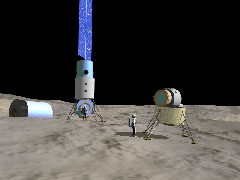
 |
|||||||
|
|
|
|
|
|
|
|
|
|
Sub-Orbital |
Orbital |
LEO Station |
Mission Statement |
Lunar Orbit |
Lunar Surface |
Mars and Beyond |
A lunar outpost represents the
technological bridge between earth orbit and interplanetary travel.
Before undertaking expeditions to Mars and beyond, spacesuits, vehicles and
operational procedures can be tested on a world just three days travel from
earth.
Using an expendable lunar cargo lander, a 5.3 mt modified "Mini-Mir" module can form the core of a lunar polar base. Certain regions of the lunar poles have the advantage of near-continuous sunlight, a temperature (~ -70° Celsius) similar to that of Mars, and the possible access to water ice within nearby craters. Crews would travel to the lunar orbital station in a lunar orbit capable OCV and shuttle between the station and the surface using a reusable lunar lander composed of a short duration, three crew module based on the Pod and a propulsion module with Methane/LOX propellant engines. Lunar cargo vehicles will refuel the lander between missions.
The first lunar surface mission can occur as early as the fourth MOV launch of the program. A total of eleven MOV launches, including three expendable cargo landings, will build up a base capable of supporting crews of three for up to six months. Building this initial capacity would require three crewed lunar landing missions and would result in the complete outfitting of both the lunar orbital station and a surface base that comprised the core module, a pressurized rover, a garage/airlock and lab module. Propellant tanks from the expendable cargo landers can provide additional living and working space. A total of eight MOV launches, including one expendable cargo vehicle could support two six month expeditions of three people every year.
An expanded base could house six people in four six-month expeditions staggered to launch every ninety days. This configuration would require a total of fifteen initial launches, including four expendable landers. Annual requirements for the six person base would be eleven launches, including two expendable landers.
The lunar surface base would be able to support extended stays on the surface, multiple EVAs over a wide area, and generally serve to develop and validate procedures for use on Mars, in addition to furthering the exploration and development of the moon itself.
All pages and images ©1999 - 2005
by Geir Lanesskog, All Right Reserved
Usage Policy
![]()